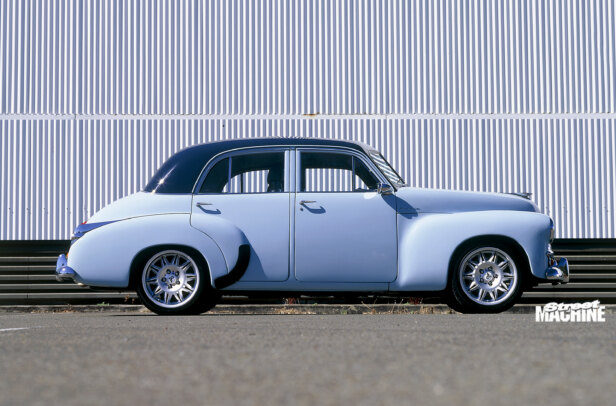Get this. A bloke named Colin Townsend calls me up and invites me to drive his FJ Holden. Not just any humble humpy – this was 1994’s Street Machine of the Year, and a Top 10 car at Summernats 8. I was excited, honoured and, well, a bit worried. What if I splatter a totally unique and expensive car all over the armco?
This is my favourite street machine and the ultimate FJ. It looks awesome, has been designed to handle like a racecar and has more than 500hp! In his ’94 SMOTY yarn, John Cadogan had this to say after his ride in the FJ through the Adelaide Hills: “This is a very special street machine. It goes. It stops. It kicks serious butt in corners. And you can clearly give it a boot-full without busting its innards.” It’s 10 years on, and I’m about to find out if the FJ lives up to its reputation.

STREET-LEGAL PHILOSOPHY
We meet Colin and his wife Violet at their Adelaide home, and I’m instantly struck by shed envy. Colin’s spotless garage features a pit, complete with serious lights, compressed air and more. We start with a look under the beast while Colin tells me his build philosophy of the car.
“I wanted to build the ultimate street-legal performance car. I wanted it to be unbreakable, have plenty of visual appeal and handle like a circuit car, yet be refined enough for road use.”

After dreaming up a wish list of desirable qualities, he set about figuring out how to achieve them, in consultation with the rego authorities from day one. The list contained such things as an optimum weight distribution of 45 per cent front and 55 per cent rear, low centre of gravity, and the lowest possible kerb weight – 1320kg.
Other key changes include a wider track – increased 23cm at the front and 17cm at the rear. With the aid of computer software (not very common in the early 90s), the suspension was designed with all the characteristics that separate your average shopping trolley from a car that really handles.

PAINTING THE TARMAC
Colin is keen to hit the road, so he fires the car up and I slide into the leather-trimmed, but beautifully minimalist, interior with the radio hidden under the seat. Everything is simple, from the classic gauges in the factory binnacle, to the old-school heater in the passenger foot well, and the original FJ horn button in the sports tiller. The SAAS bucket seats are mounted further back than standard, so all necessary controls are mounted on the Torana steering column or on the seat frame – you couldn’t reach them if they were on the dash.
On the road I’m struck by how well-sorted the car is – no rattles, no fumes, no squeaks – everything works perfectly, a rare thing on a car of this era. We come to a stop on a relatively quiet piece of road and I say my prayers as Colin stabs the throttle and lifts the clutch. The rear tyres might be 345mm wide, but they spin with ease before Col shifts into second and we paint another set of black marks on the tarmac. Into third and we’ve built up some serious speed as a tight left-hander fast approaches. I get that queasy feeling as Colin dabs the brakes before the FJ goes round the corner like it’s on rails.


GIVE US A GO
Colin pulls up and we swap seats. Colin warns me that the lightened flywheel and twin-plate clutch can be a bit tricky. The pedals are close together, but even with my size 11 clodhoppers they work like a charm, and I manage to get rolling without a fuss.
The engine is a delight with a great response, and as I go through the gears the shift light illuminates at 5800rpm – without it, I’d be hitting the 6300rpm limiter easily in each gear. Likewise, the Top Loader has been set up beautifully and each cog falls into gear without a drama. The brakes are unassisted but easy to get used to, as is the steering, despite the small steering wheel and wide rubber.
We’re soon on a nice piece of twisting road and I have to remind myself I’m sitting in a 50-year-old Holden. It sits flat as a tack through corners, turns-in beautifully, and handles bumps and potholes without fuss, totally free of the bump steer that plagues many modified early Holdens. This is like no other old-school street machine I’ve ever driven. Reality has come face to face with the legend and come away grinning ear to ear.

STAND BACK AND ADMIRE
It’s photographer Bowden’s turn to get down to business. This gives me the opportunity to admire the arrow-straight body, especially the impeccable panel gaps and amazing all-steel widened guards, each one containing over 50 pieces of steel hand-beaten into shape, trimmed, hammer welded and then metal finished. The rear doors, grill, stone trays and bumpers have all been widened to match, giving the whole car a factory feel. The car is 12 inches wider than stock.
The whole package is an astounding achievement, but the time has come for Colin to sell. As he says, the car would be perfect for Grand Prix rally style events and there is plenty of scope to update it.
“You could fit power steering without a worry and there’s room within the South Australian rego laws to fit a turbo to this car,” Colin says.





Comments